Inside: 28 free vintage botanical plant prints from Johannes Gessner Tabulae Phytographicae.
Johannes Gessner was born in Zurich, Switzerland, in 1709. His father was a doctor, and Gessner was expected to follow in his footsteps. However, he became interested in botany at a young age and decided to pursue it as a career.
In addition to botany, Gessner was also interested in art. He was a talented artist and used his skills to create detailed illustrations of plants for his books.
Gessner’s most famous work, Tabulae phytographicae analysin generum plantarum exhibentes, was published in 1759. It contained detailed illustrations and descriptions of various plant genera and was meant to be a comprehensive guide for botanists. It helped establish a new classification system and gave botanists a valuable tool for studying and understanding plants.
Despite his contributions to botany, Gessner was not widely recognized during his lifetime. Only after his death did his work begin to receive the recognition it deserved.
Today, Gessner is considered one of the most important botanists of the 18th century. His work on plant classification and his beautiful illustrations have had a lasting impact on botany.
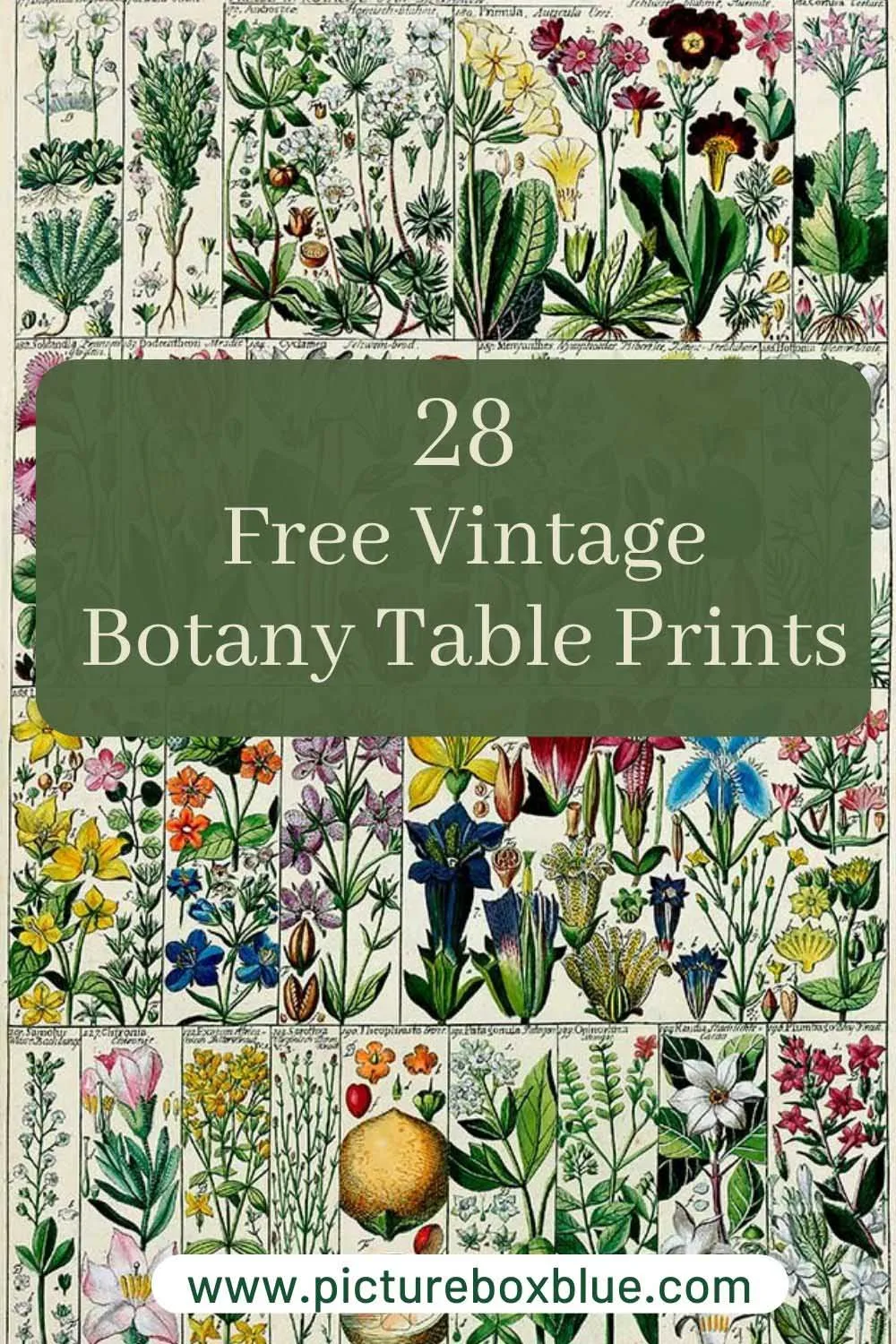
Johannes Gessner and Phytography
In the context of Johannes Gessner’s work, the term “phytographic” refers to the study and depiction of plants through detailed illustrations. Gessner’s book, Tabulae phytographicae, was a collection of illustrations depicting various plant genera in great detail, focusings on their reproductive structures.
Therefore, “phytographic” can be understood as a combination of “phyto-” (meaning plant) and “-graphic” (meaning to depict or represent visually). Gessner’s phytographic work aimed to provide botanists with a visual reference for identifying and classifying different plants based on their reproductive structures.
Gessner’s illustrations were created using various techniques, including pen-and-ink drawings, watercolours, and etchings. They were meticulously executed and showed a level of precision and accuracy that was unusual for the time.
One of the most significant aspects of Gessner’s illustrations was that they provided a visual reference for botanists. Before the publication of Tabulae phytographicae, botanists relied on written descriptions of plants, which could be vague and imprecise. Gessner’s illustrations allowed botanists to see the plants in question in detail, which made it easier to identify and classify them.
Gessner’s illustrations were significant because they helped establish a new botanical illustration standard. His meticulous attention to detail and emphasis on accuracy set a new bar for botanical artists, and his work influenced many other illustrators in the years to come.
Overall, Joannes Gessner’s illustrations significantly contributed to the botany field. They provided a visual reference for identifying and classifying plants, helped to establish a new standard for botanical illustration, and influenced the work of many other artists in the field.
How To Download Johanne Gessner’s Plant Tables
Click on the title above the plant table you want to download. A higher-resolution image will open in a new window; click on that image to save or print it.
All the Johannes Gessner botanical illustrations are in the Public Domain so are therefore copyright-free.
Plant Tables 1- 7 Monandria, Diandria and Triandria
Botany Plant Table 1: Monandria
Monandria is a term used in botany to describe plants that have flowers with only one stamen. In other words, these plants have a single male reproductive structure that produces pollen.
Examples of mondanria plants include:
- Orchids: Gessner painted several species of orchids in his work, including the Cattleya labiata, which has a large, showy flower.
- Ginger: The ginger family (Zingiberaceae) contains many species with just one stamen, including the common ginger plant (Zingiber officinale).
- Iris: Some species of iris, such as the Iris reticulata, have just one stamen.
- Lily: The lily family (Liliaceae) contains many species that have just one stamen, including the daylily (Hemerocallis).
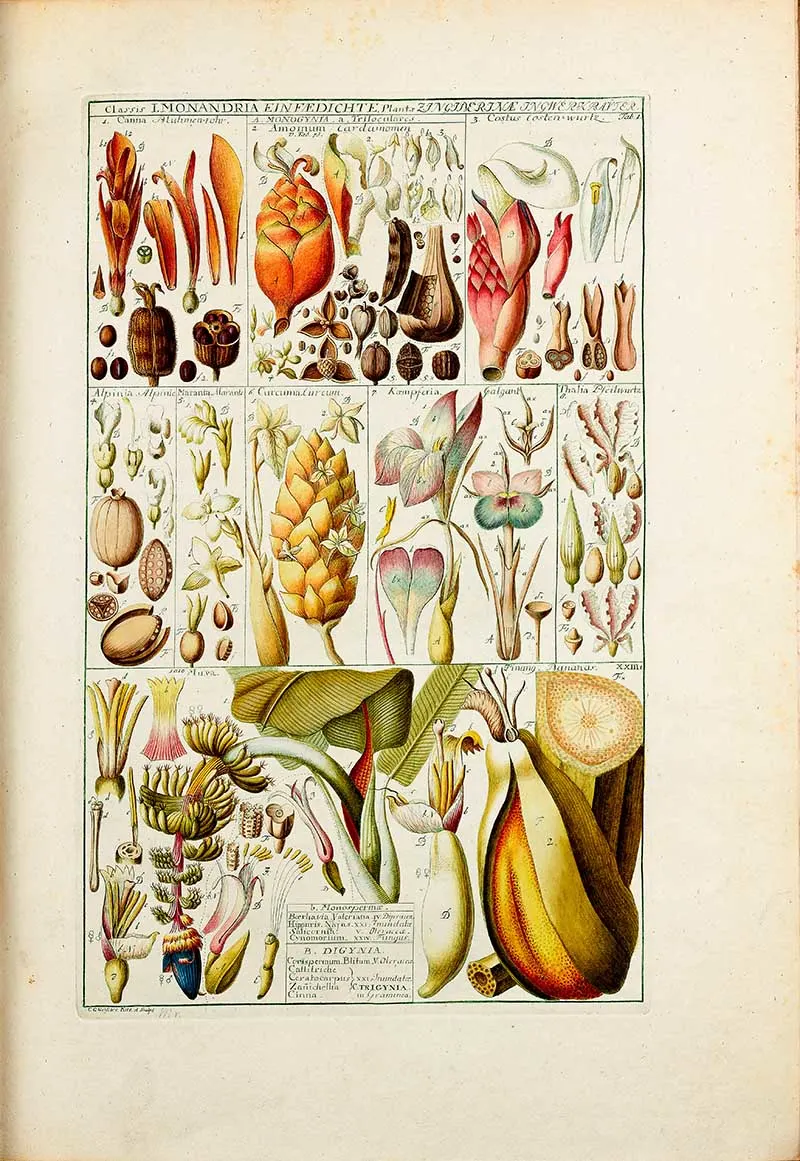
Botany Plant Table 2: Diandria
Diandria plants have two stamens. Examples of these plantes include:
- Peas: Gessner painted several species of pea, including the Lathyrus pratensis, which has bright purple flowers.
- Sage: Many species in the sage family (Lamiaceae) have two stamens, including the common garden sage (Salvia officinalis).
- Nightshade: including the tomato plant (Solanum lycopersicum).
- Snapdragon: Gessner painted several snapdragon species, including the Scrophularia nodosa, which has clusters of small, dark purple flowers.
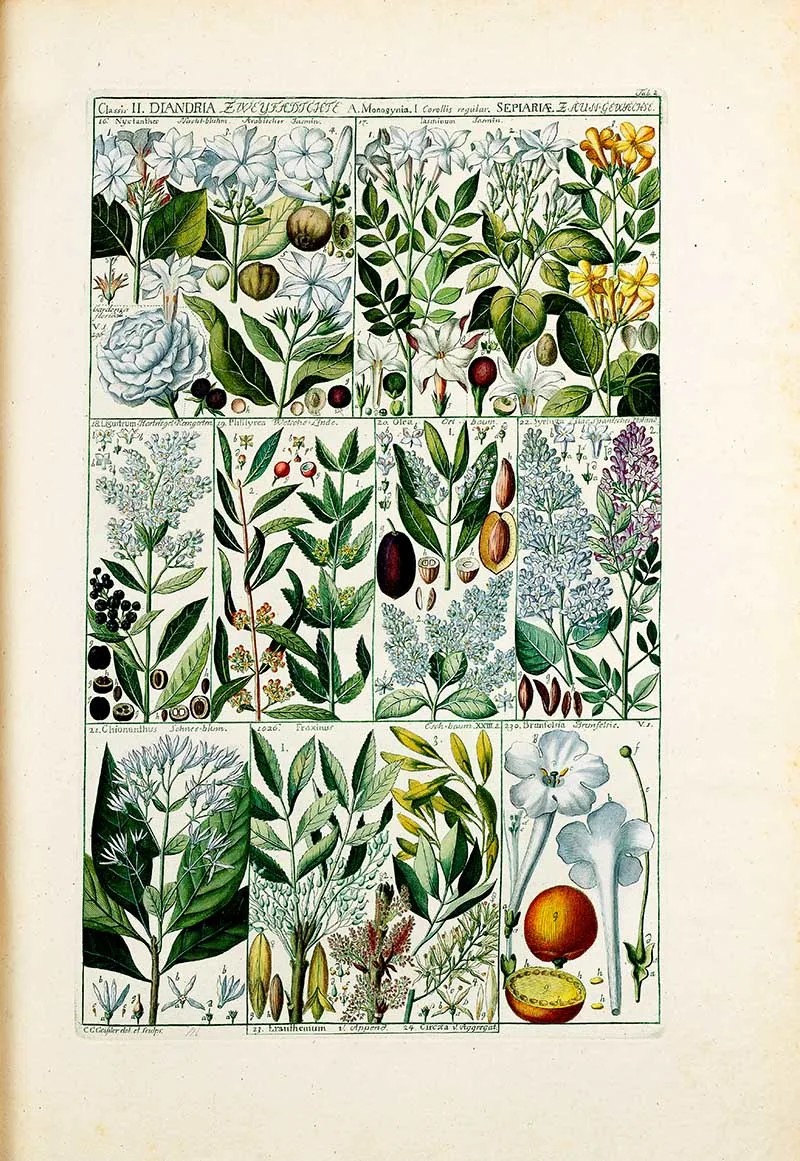
Botany Plant Table 3: Diandra Pepper
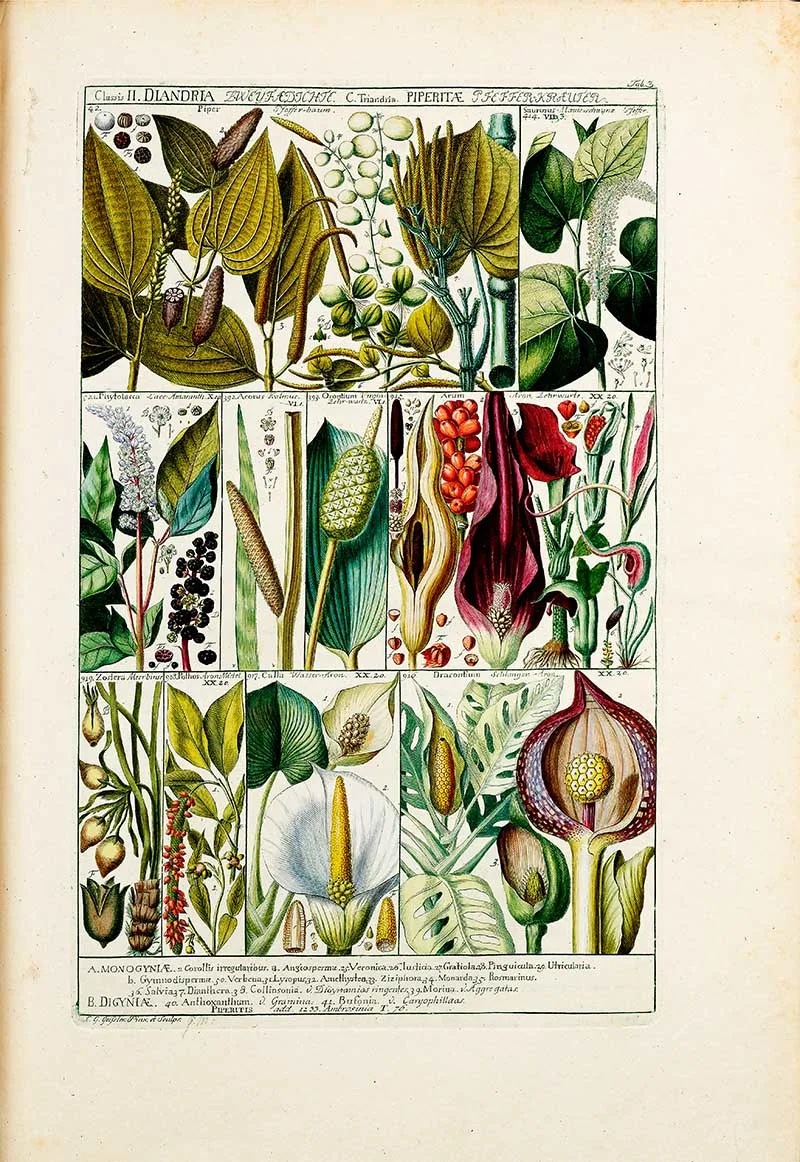
Botany Plant Table 4: Triandra
Plants in this group have three stamen for reproduction, examples include:
- Ginger: Alpinia zerumbet. Gessner painted this species in his book, which has beautiful pink flowers.
- Iris: Iris germanica has three stamens. Gessner painted several species of iris in his work, including the Iris sambucina, which has lovely blue-purple flowers.
- Asparagus: The Asparagus family (Asparagaceae) contains many species with three stamens, including the Asparagus officinalis.
- Hyacinth: Some hyacinth species (Hyacinthaceae) have three stamens, such as the Hyacinthus orientalis, which has beautiful pink, blue, or white flowers.
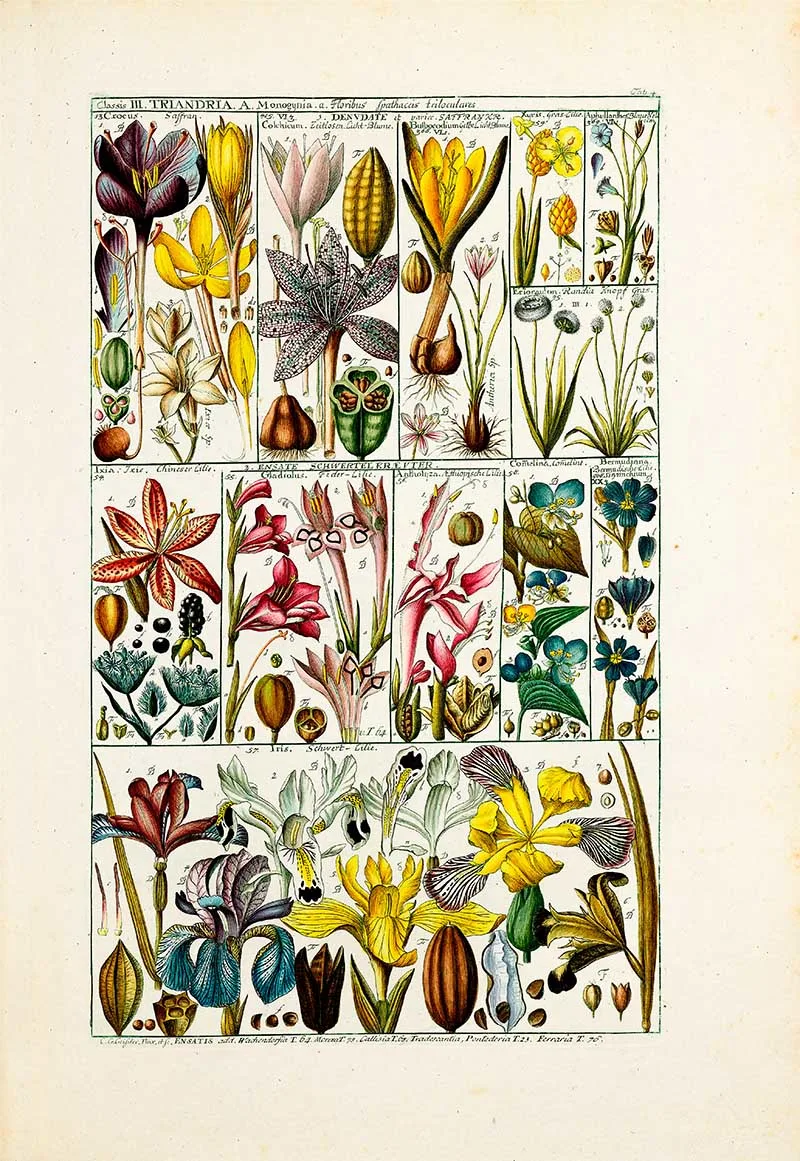
Botany Plant Table 5 – Triandria 2
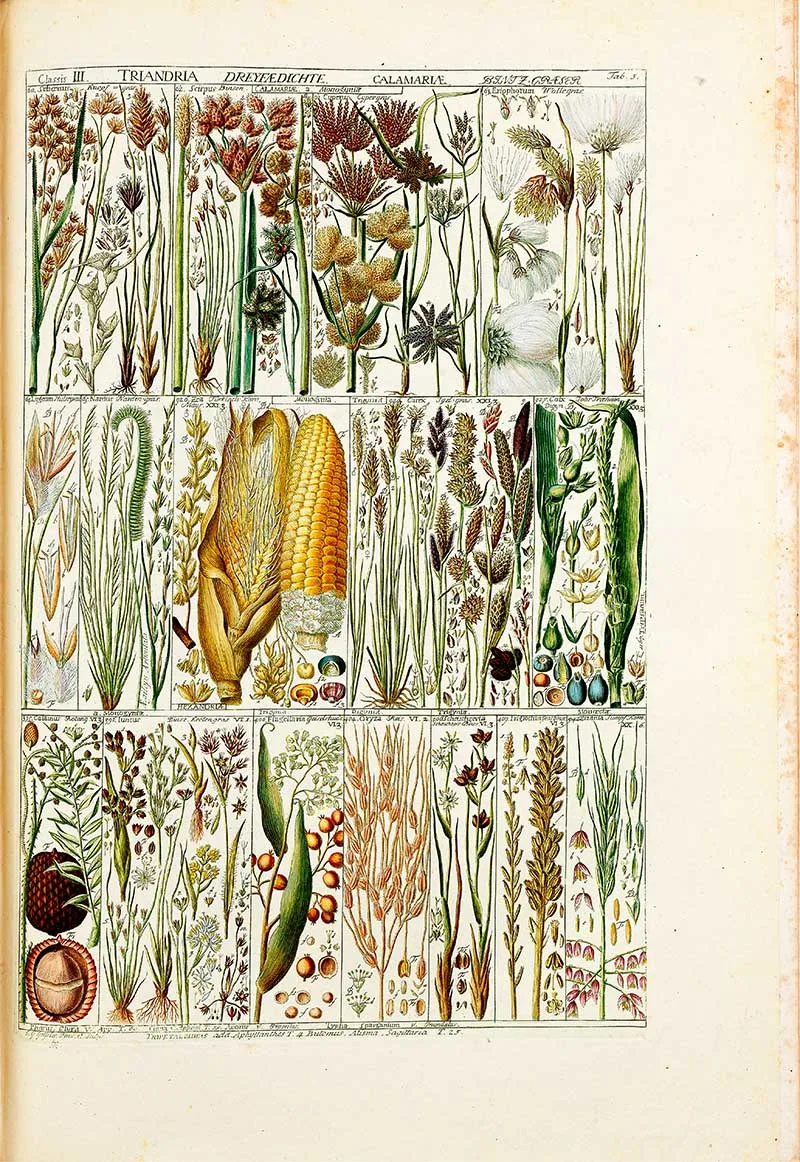
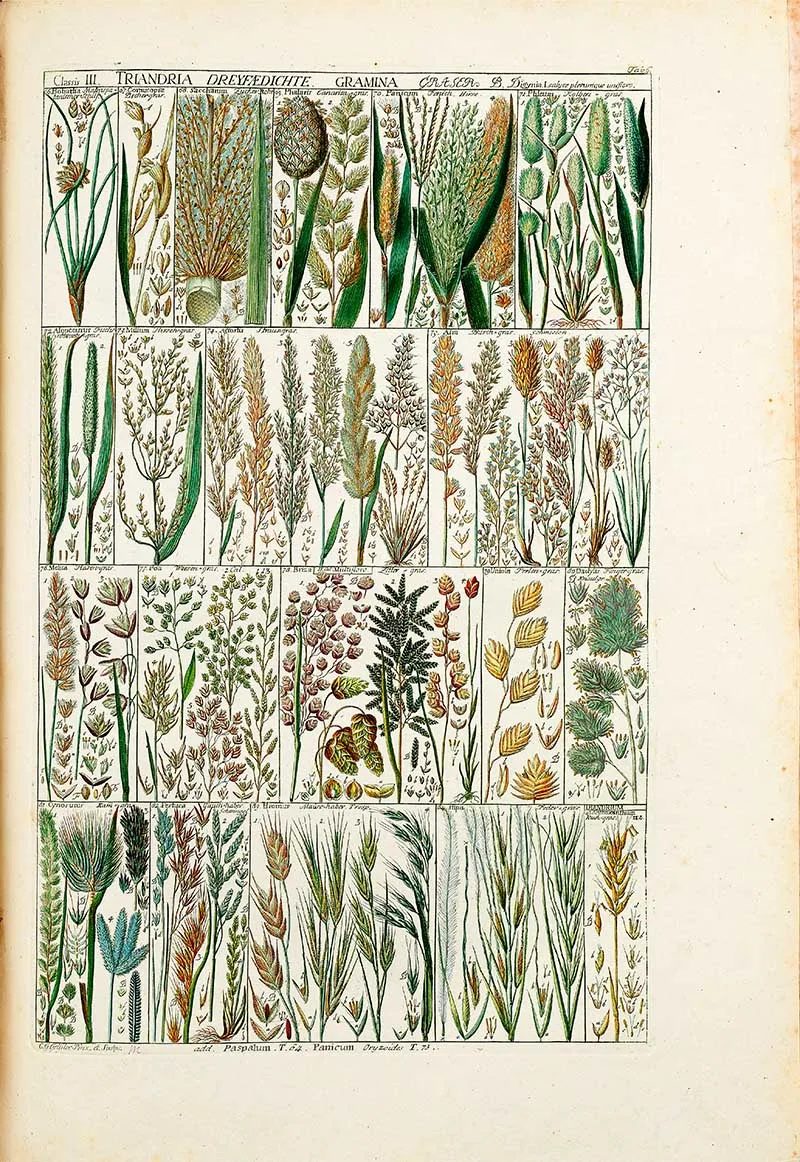
Gessner Plant Table 7: More Triandria Grasses
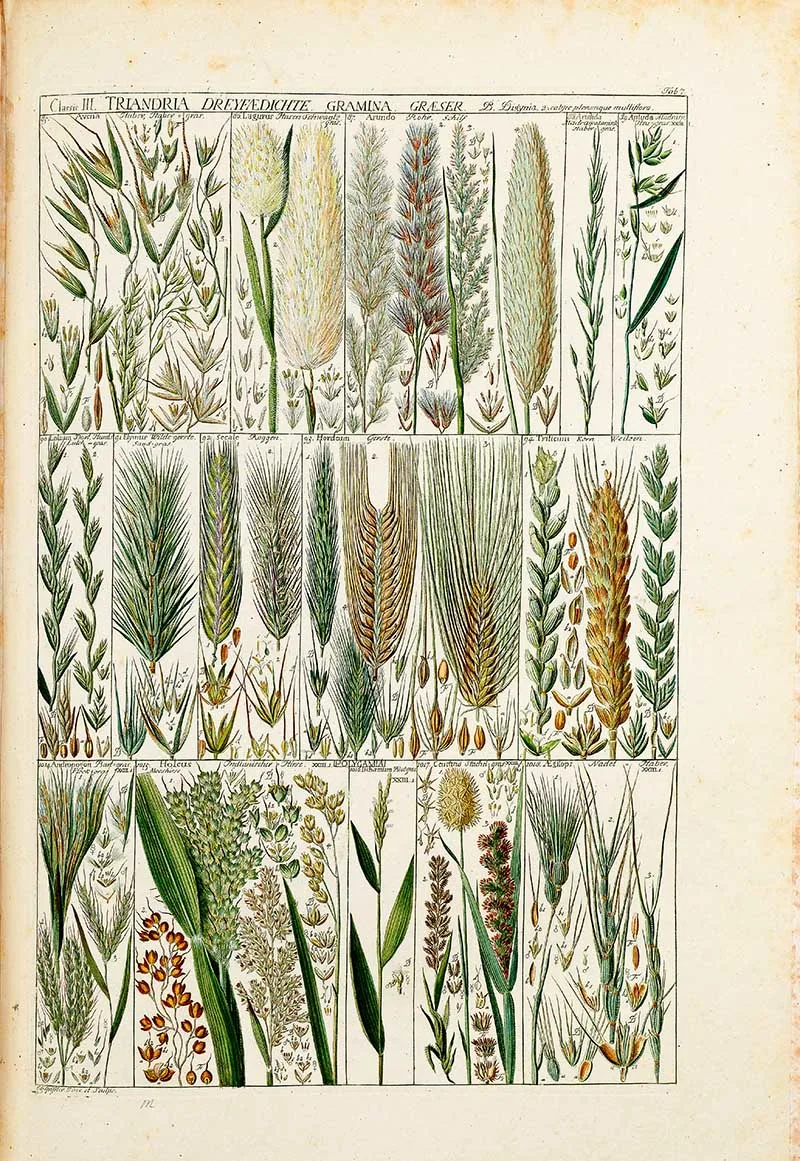
Plant Tables 8-10 Tetrandria
Botany Plant Table 8: Tetrandria
A group of plants having four stamens in each flower.
Here are a few examples of Tetrandria plants that Johannes Gessner painted in his book:
- Lilac: The lilac family (Oleaceae) contains many species with four stamens, including the common lilac (Syringa vulgaris), which has lovely purple or pink flowers.
- Geranium: Gessner painted several species of geranium in his work, including the Geranium robertianum, which has bright pink flowers.
- Purslane: Portulaca grandiflora, which has vibrant red, pink, yellow, or white flowers.
- Bittersweet: American bittersweet (Celastrus scandens), which has small greenish-yellow flowers.
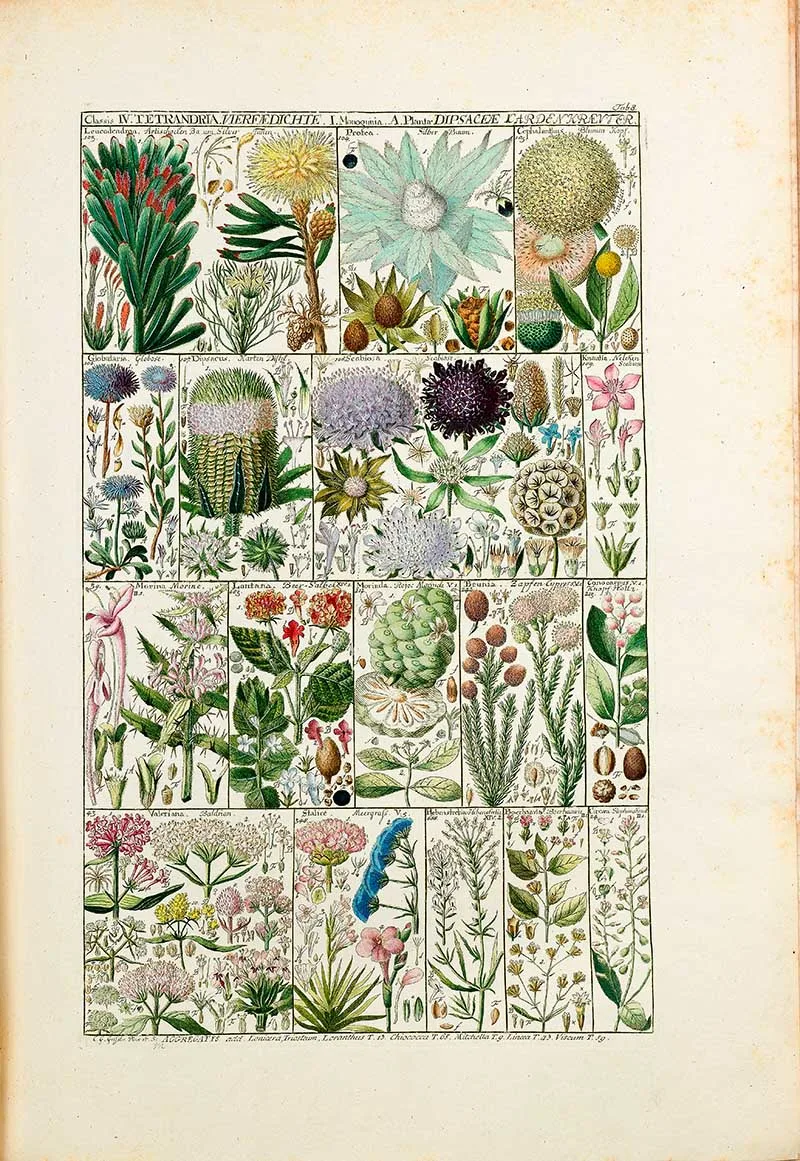
Botany Plants Table 9: Tetrandria Stellatae
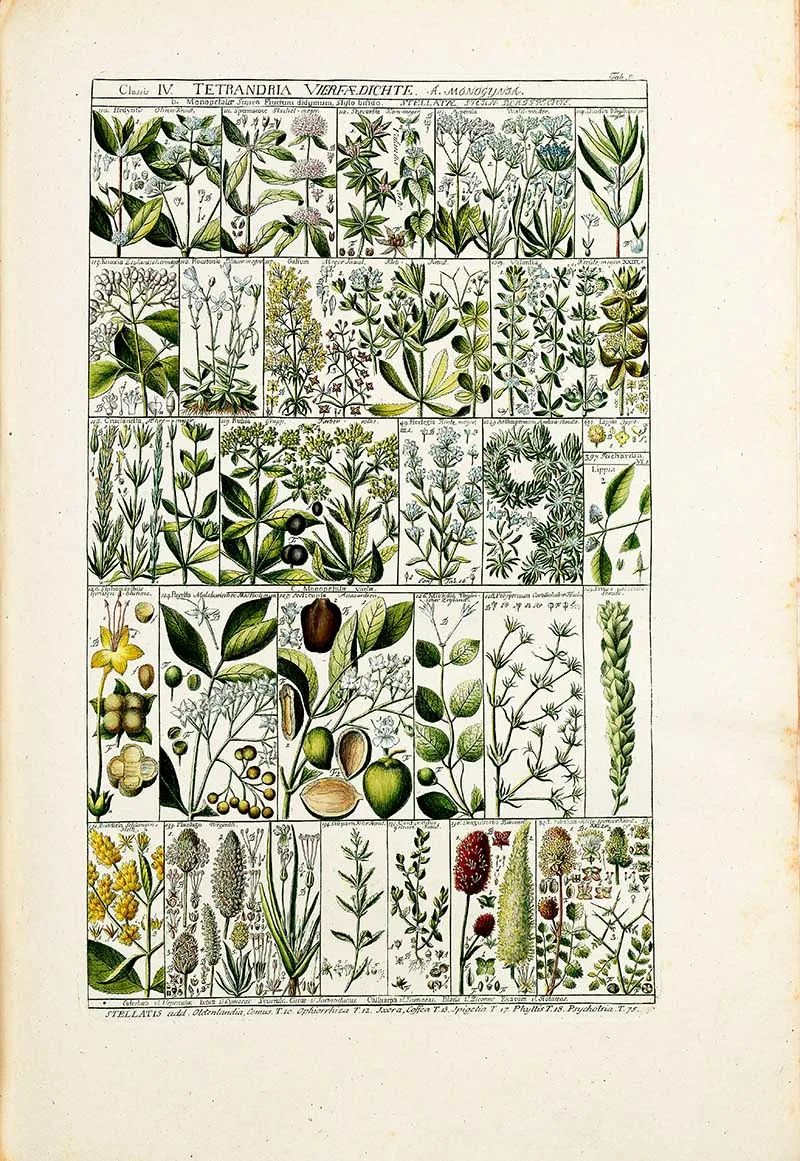
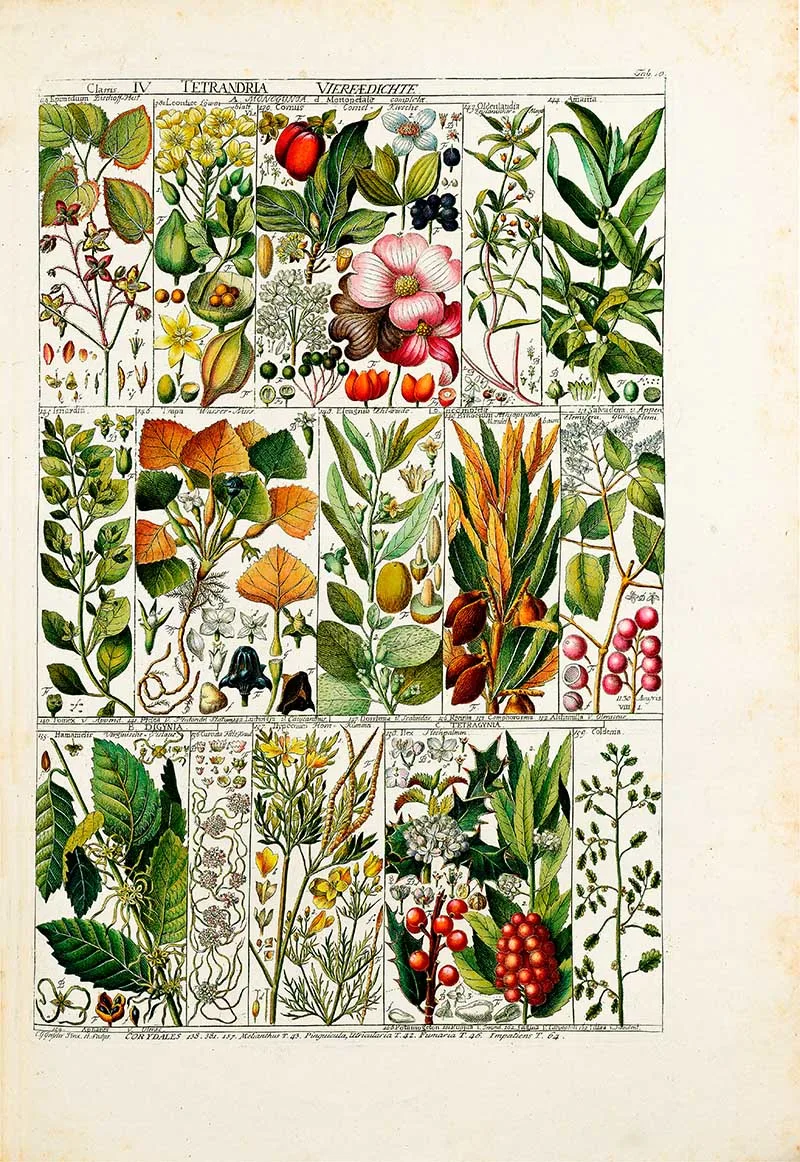
Phytography Tables 11-21 Pentandria Plants
Botany Plant Table 11: Pentandria
Pentandria plants have five stamens in each flower.
Here are a few examples of Pentandria plants that Johannes Gessner painted in his book:
- Rose: The rose family (Rosaceae) contains many species with five stamens, including Rosa gallica, which has beautiful pink, red, or white flowers.
- Morning Glory: Some species of morning glory (Convolvulaceae) have five stamens, such as the Ipomoea hederacea.
- Lily: the Lilium candidum has lovely white flowers.
- Petunia: the Petunia hybrida has bright pink, purple, or white flowers.
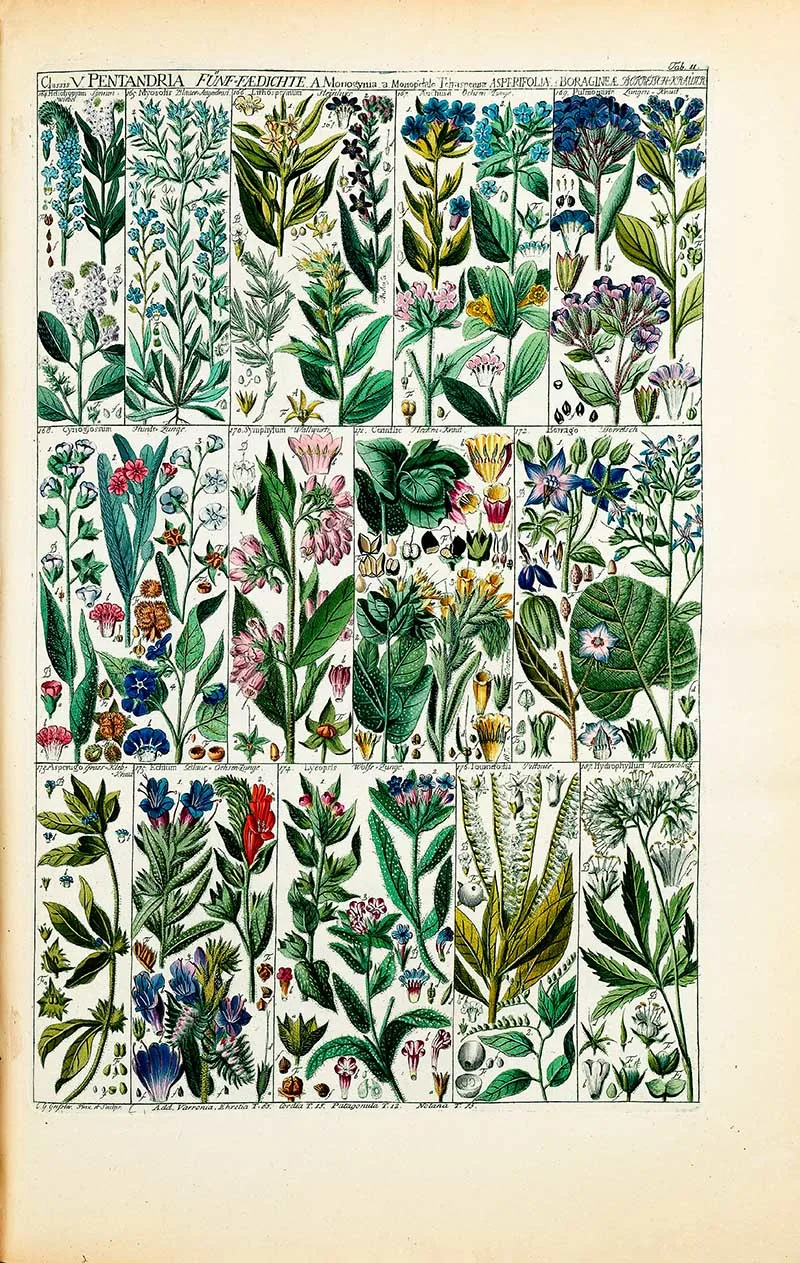
Botany Plant Table 12: Pentandria 2
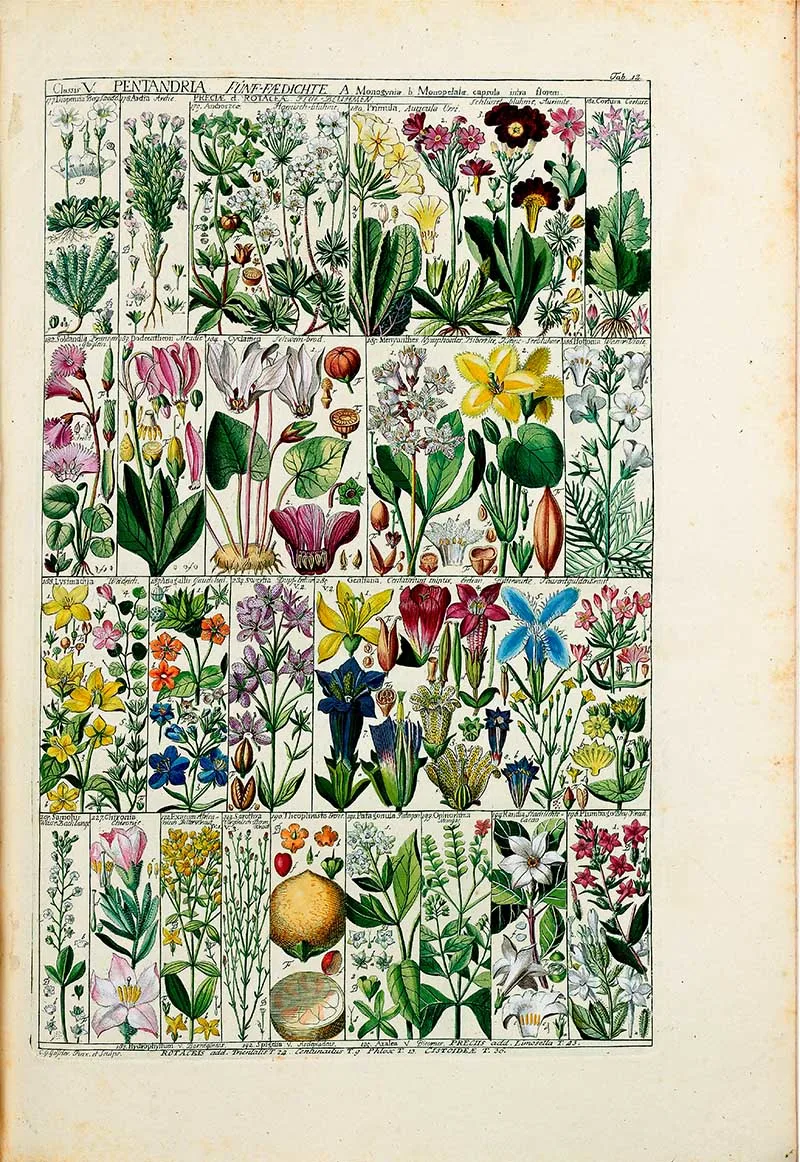
Botany Plant Table 13: Pentandria Campanulaceae
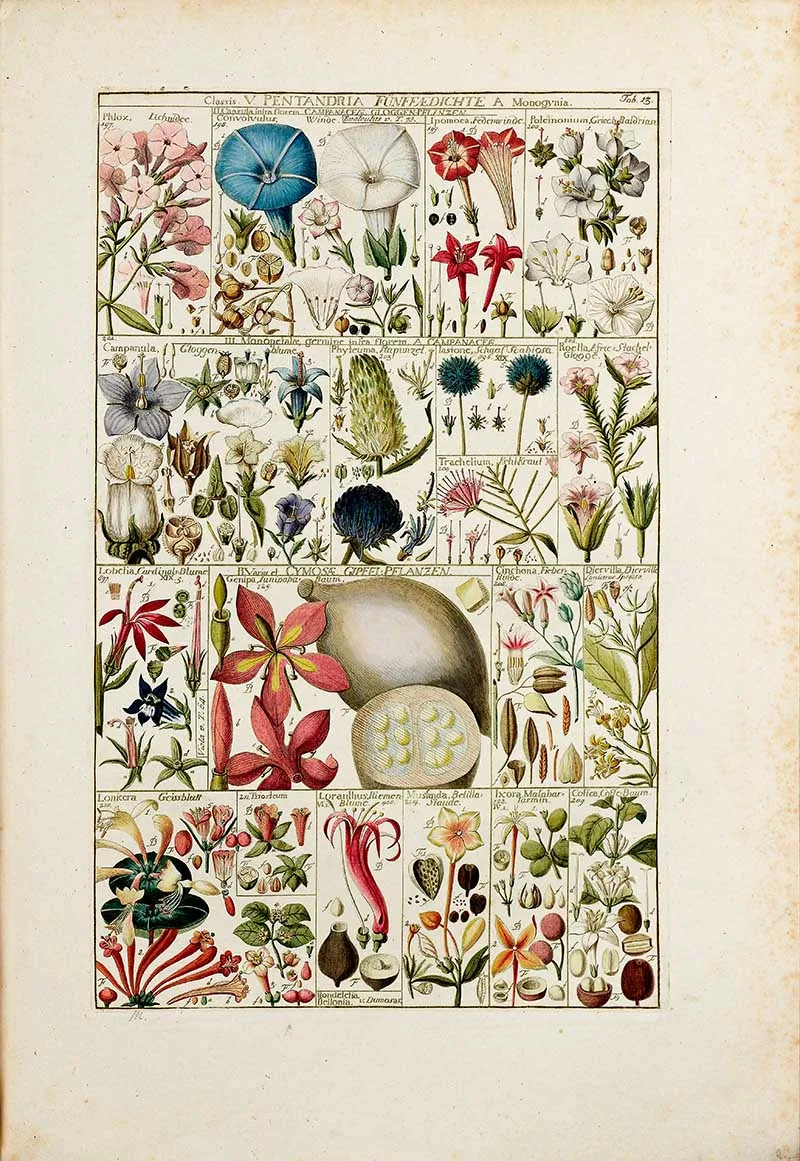
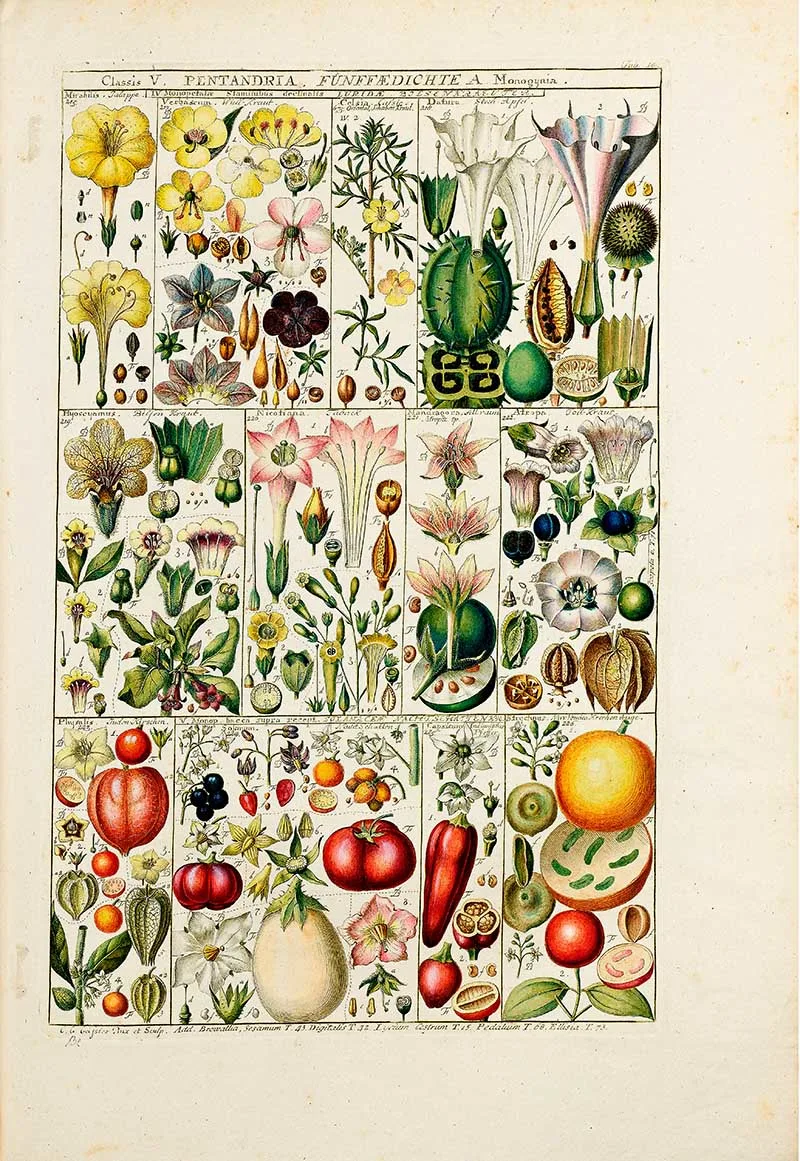
Botany Plant Table 15: Pentandria 5
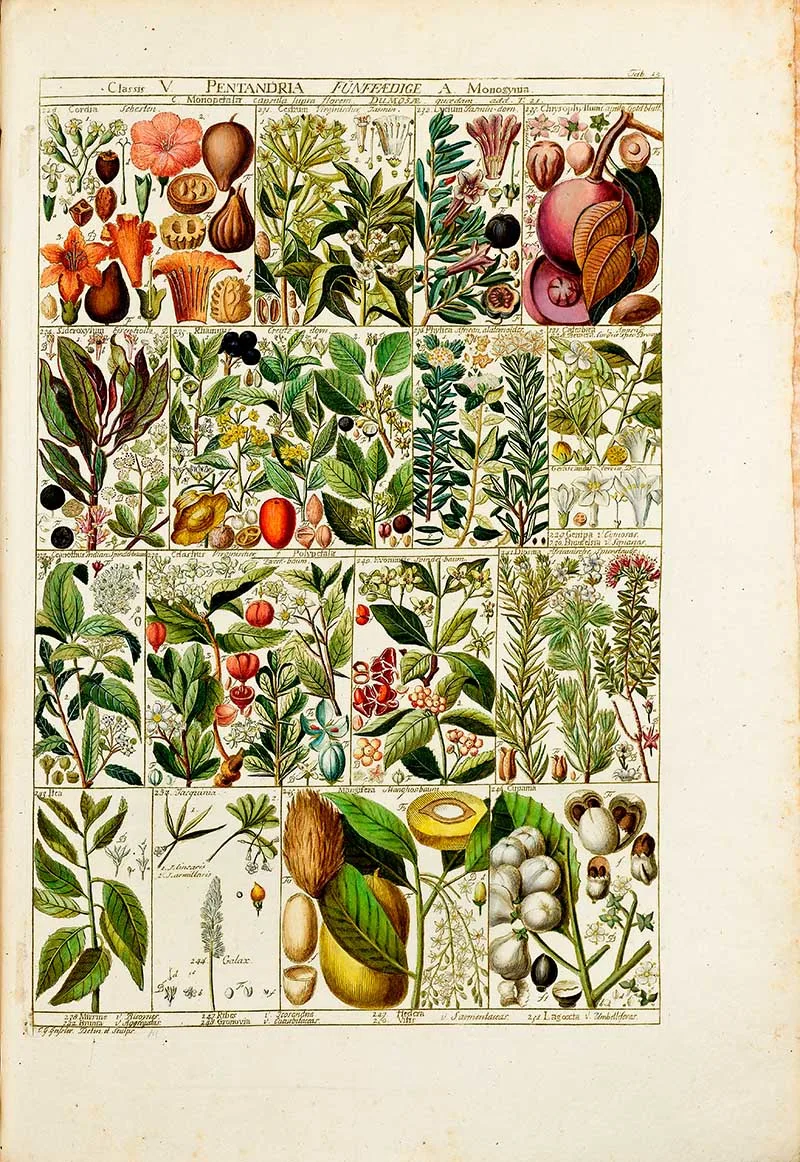
Botany Plant Table 16: More Pentandria Plants
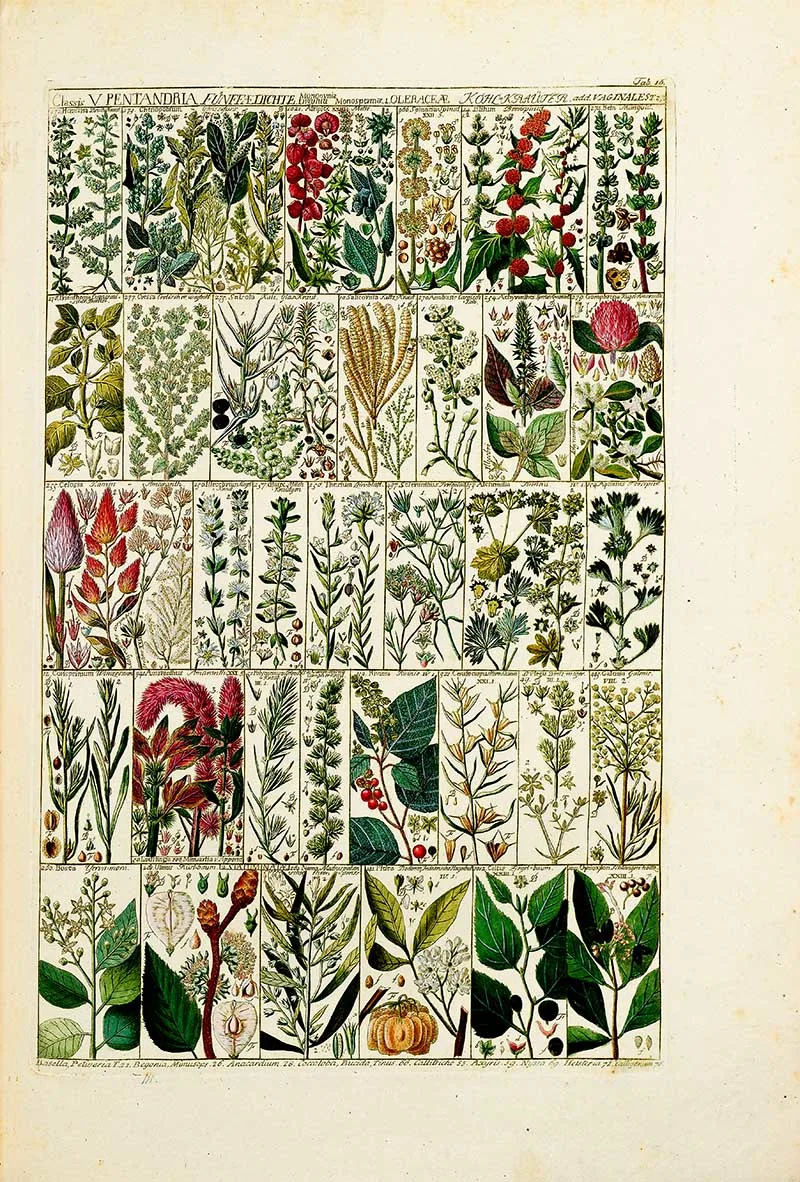
Plant Table 17: Pentandria Plants 7
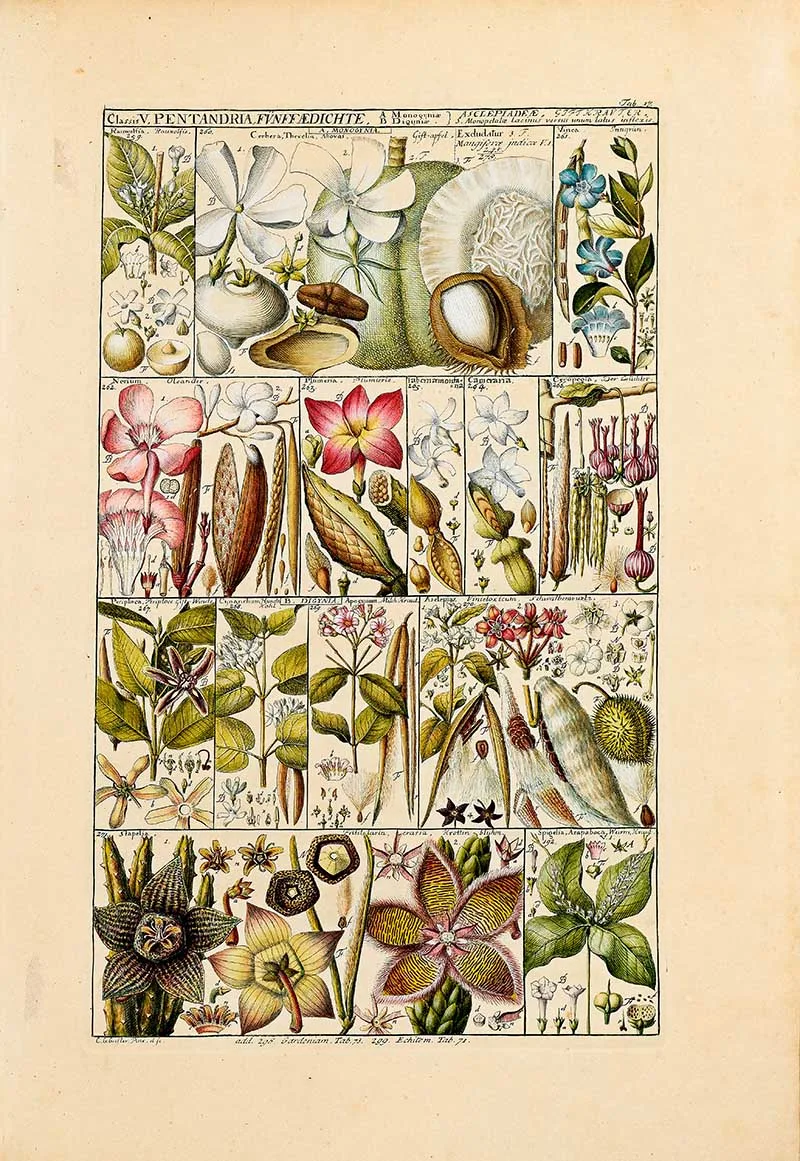
Plant Table 18: More Pentandria Plants
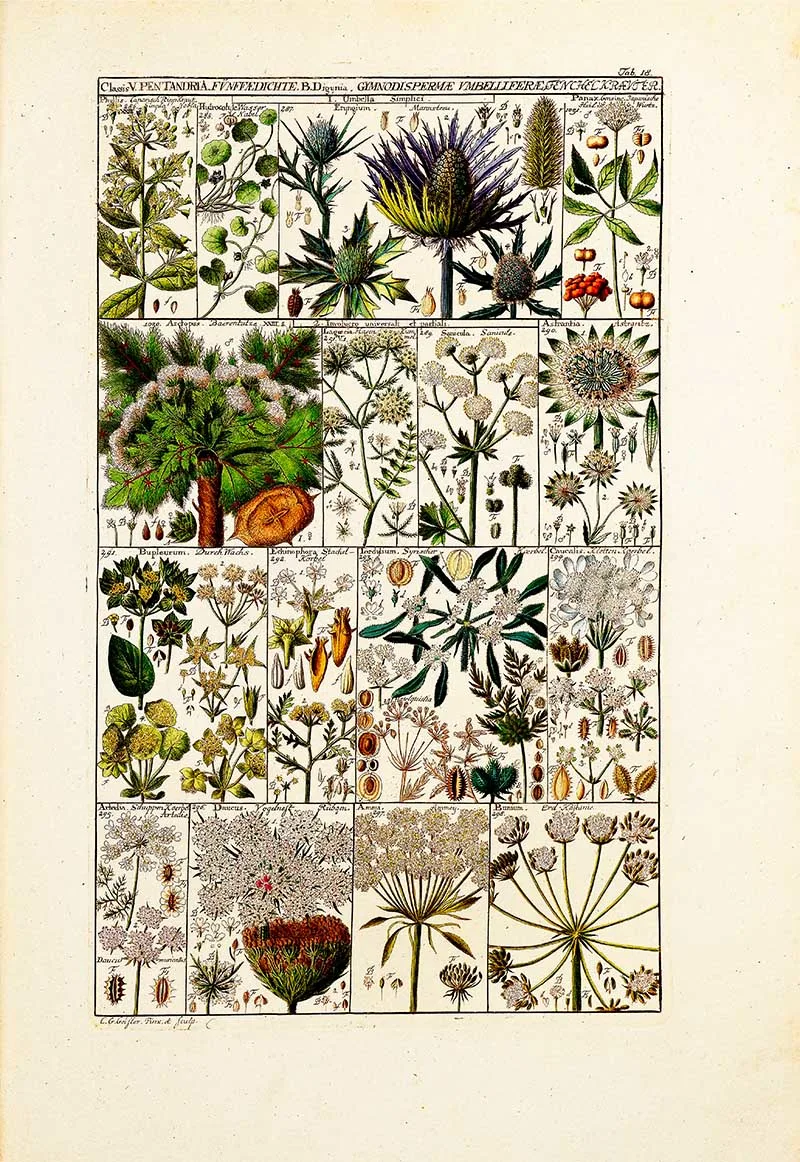
Vintage Botany Plant Plate 19: Pentandria, Hemlocks
The genus name “Conium” refers to koneios, the Greek word for ‘spin’ or ‘whirl’, alluding to the dizzying effects of the plant’s poison after ingestion.
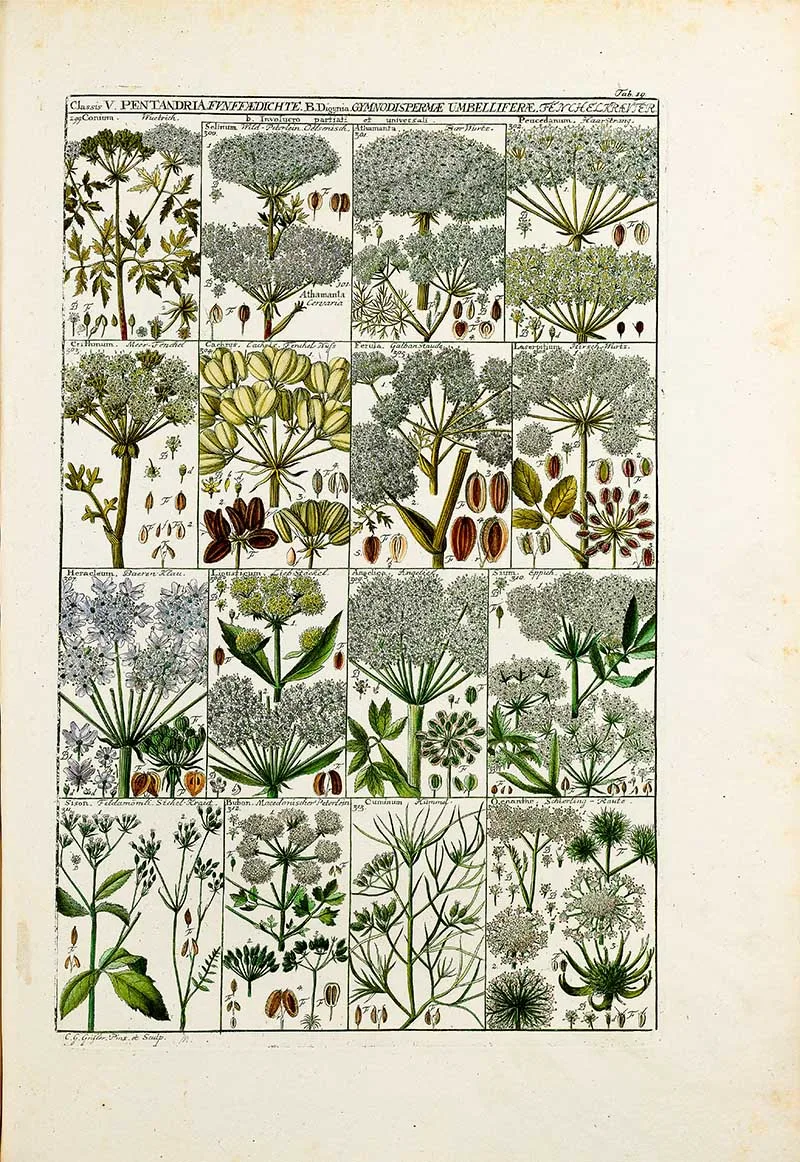
Botany Plant Table 20: Pentandria Plants 10
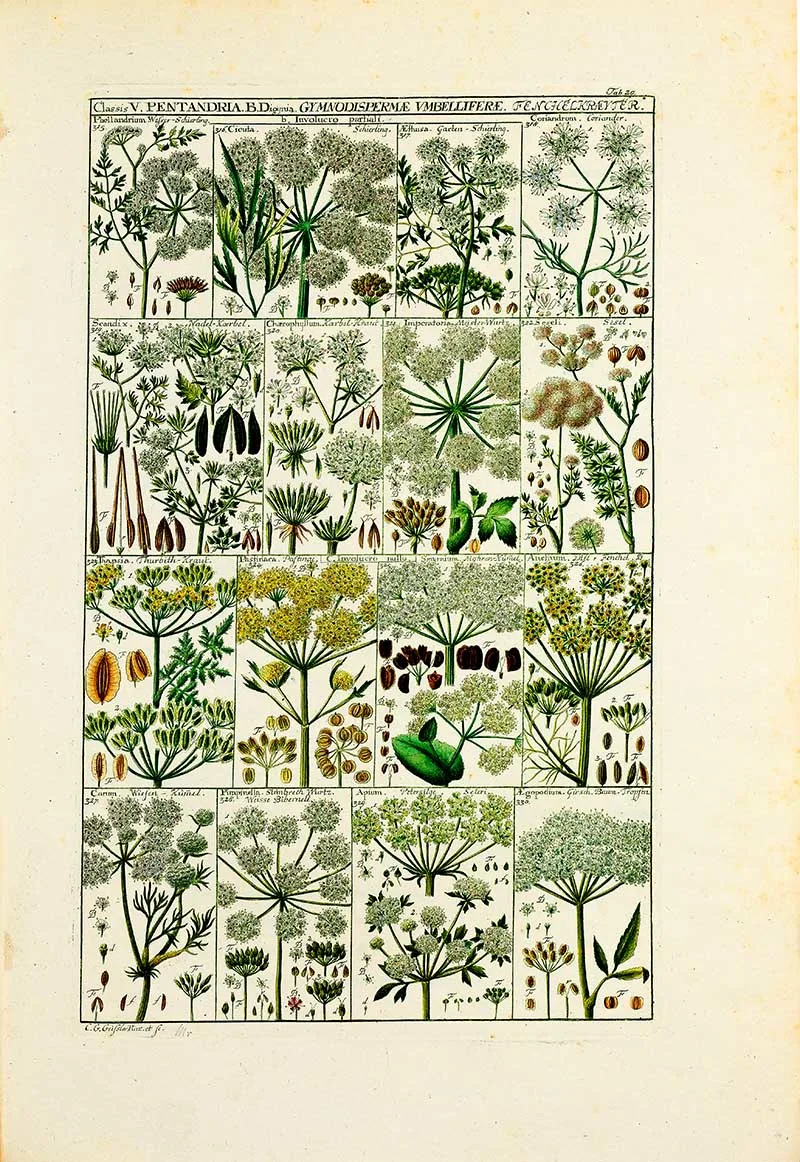
Plant Table 21: More Pentandria Plants 11
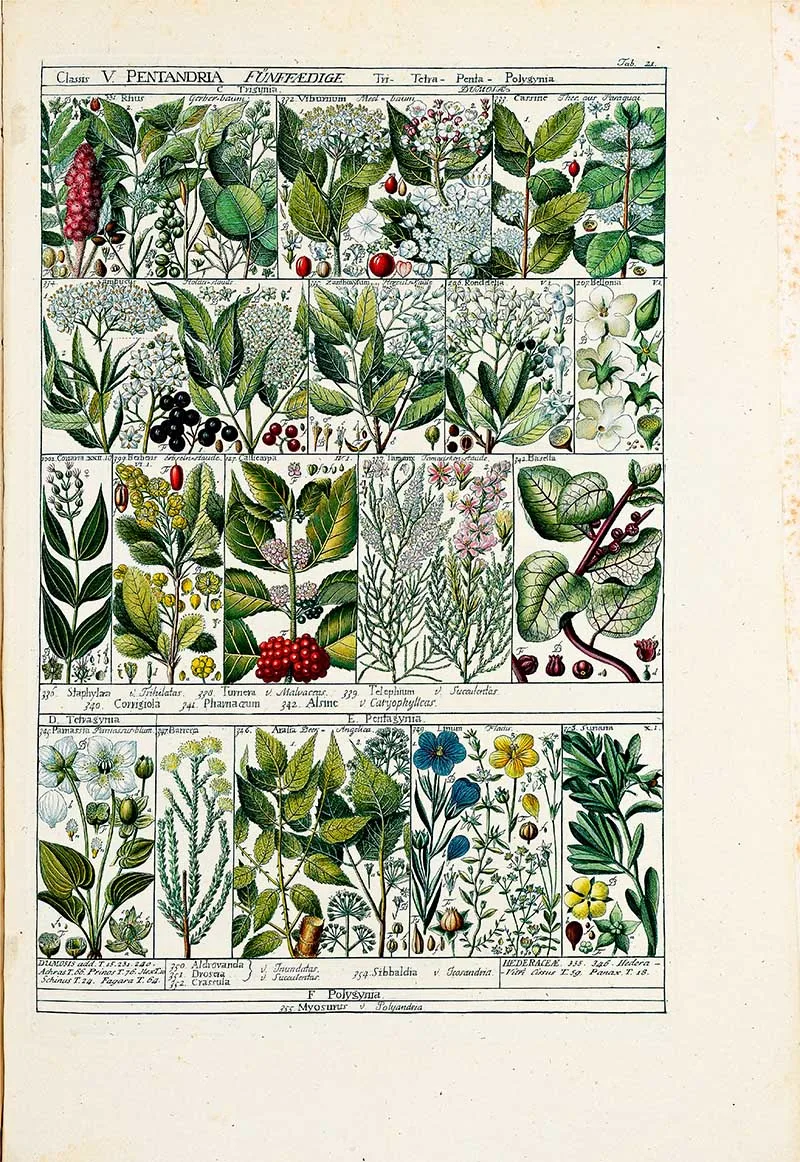
Phytographic Plant Tables 22-25 Hexandria
Hexandria plants have six stamens.
Some examples of Hexandria plants painted by Gessner include:
- Gladiolus communis – Common gladiolus
- Narcissus tazetta – Paperwhite narcissus
- Crocus vernus – Spring crocus
- Muscari comosum – Tassel hyacinth
- Iris pseudacorus – Yellow flag iris
- Allium moly – Yellow onion
- Hyacinthus orientalis – Oriental hyacinth
- Lilium bulbiferum – Fire lily
These highly detailed illustrations accurately depict the plants’ unique features, such as the shape and arrangement of their leaves, flowers, and reproductive organs.
Botany Plant table 22: Hexandria plants – palm nuts
This phytographic table of Johannes Gressner are drawings of palm nut plants such as the coconut.
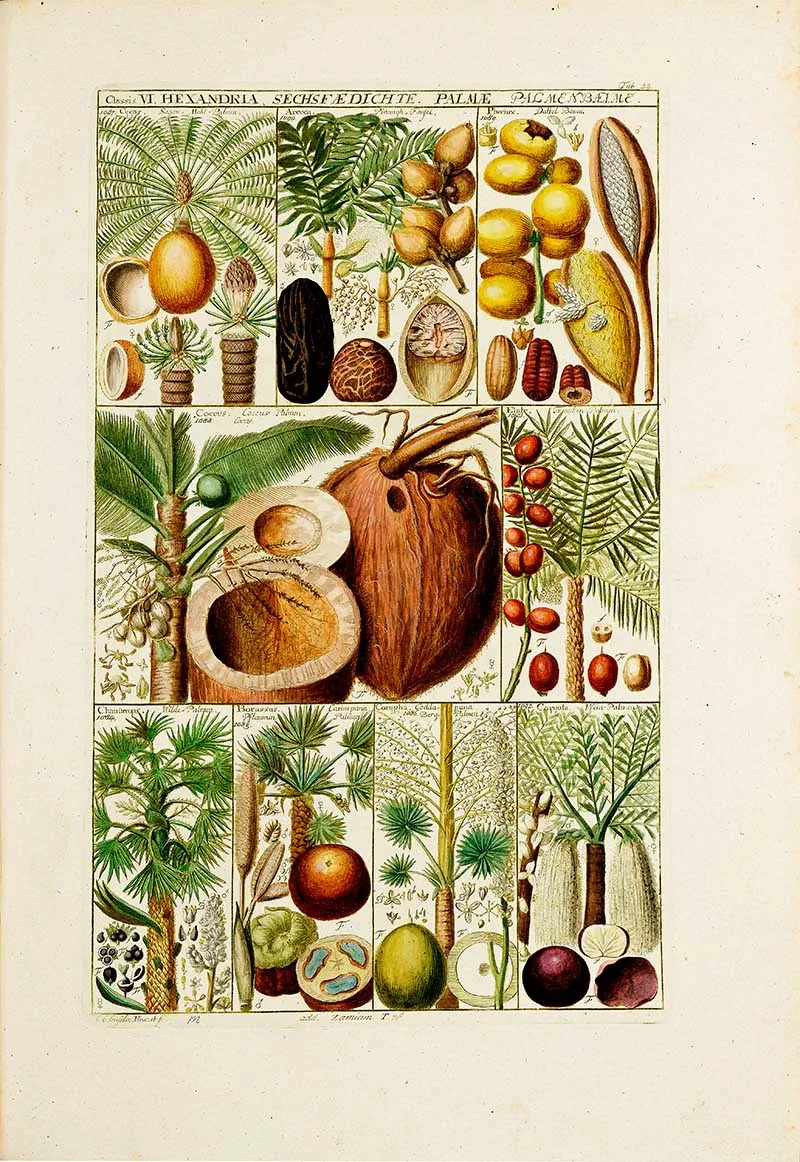
Botany Plant Table 23: Hexandria Pineapple
This botany plant table contains a lovely example of the pineapple plant and flowers.
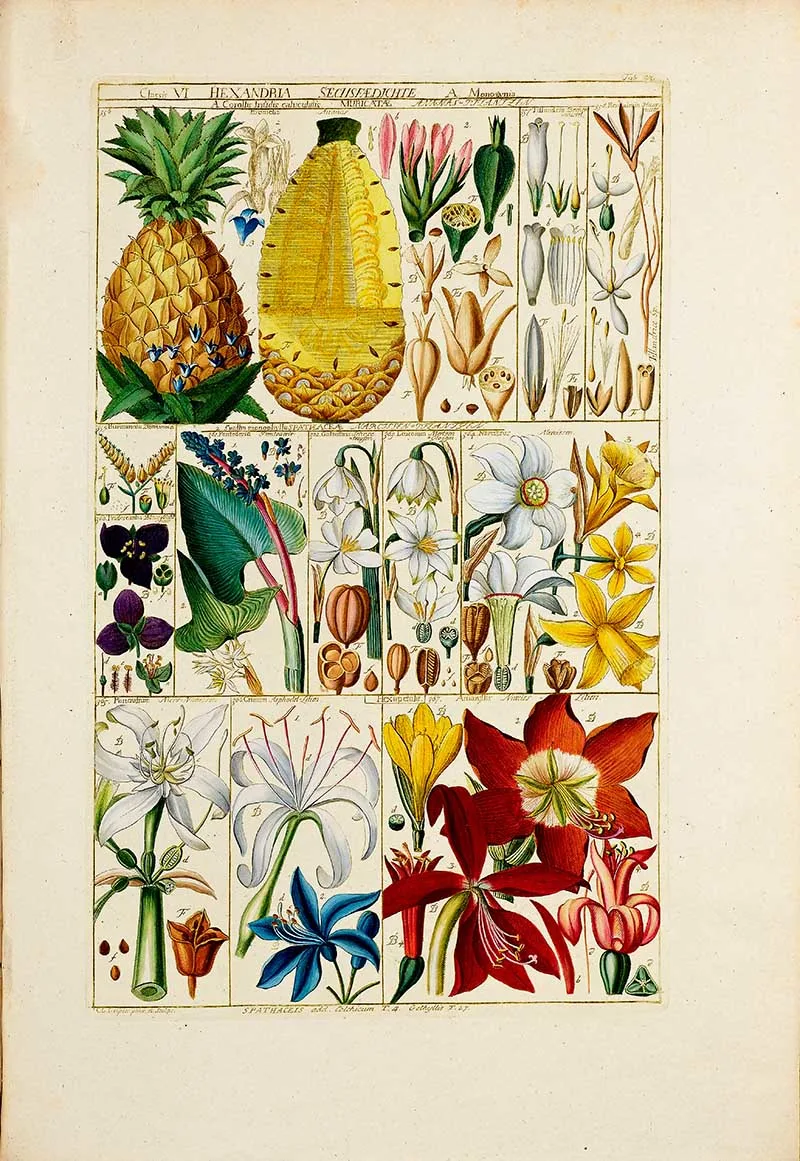
Botany Plant Table 24: Hexandria Flowers
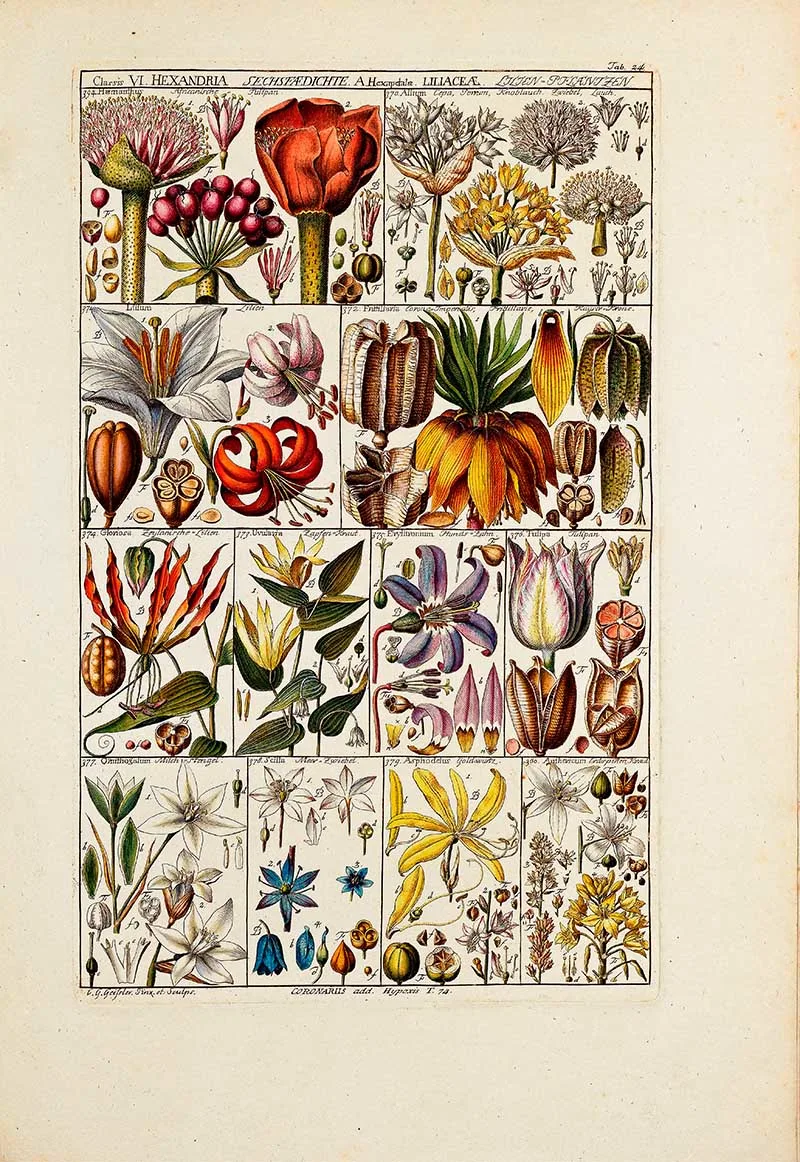
Botany Plant Table 25: Hexandria Plants 4
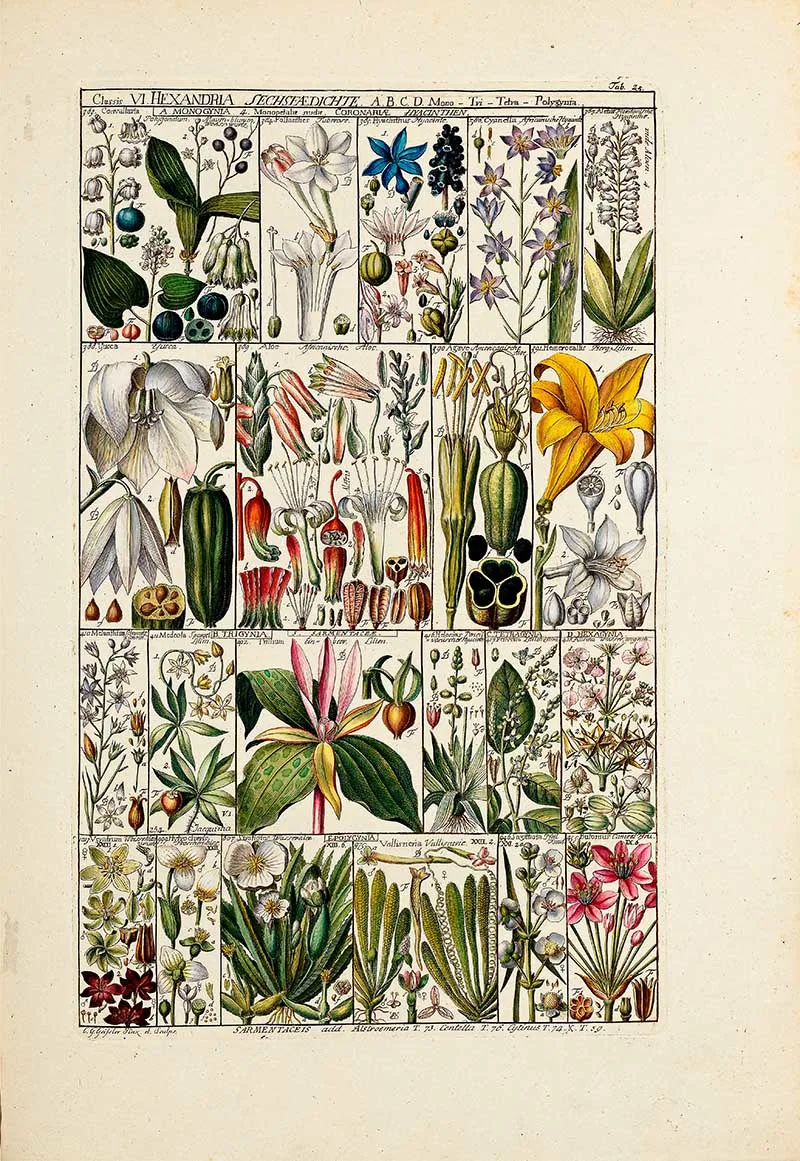
Heptandria, Enneandria Decandria Botany Tables 26-28
Heptandria is a class of plants in which the flowers have seven stamens. Some examples of Heptandria plants painted by Gessner include:
- Fuchsia coccinea – Scarlet fuchsia
- Pelargonium zonale – Zonal geranium
- Cypripedium acaule – Pink lady’s slipper orchid
- Schisandra chinensis – Chinese magnolia vine
- Oxalis corniculata – Creeping wood sorrel
- Agave americana – Century plant
- Sedum acre – Goldmoss stonecrop
Vintage Botany Plant Table 26: Heptandria Plants
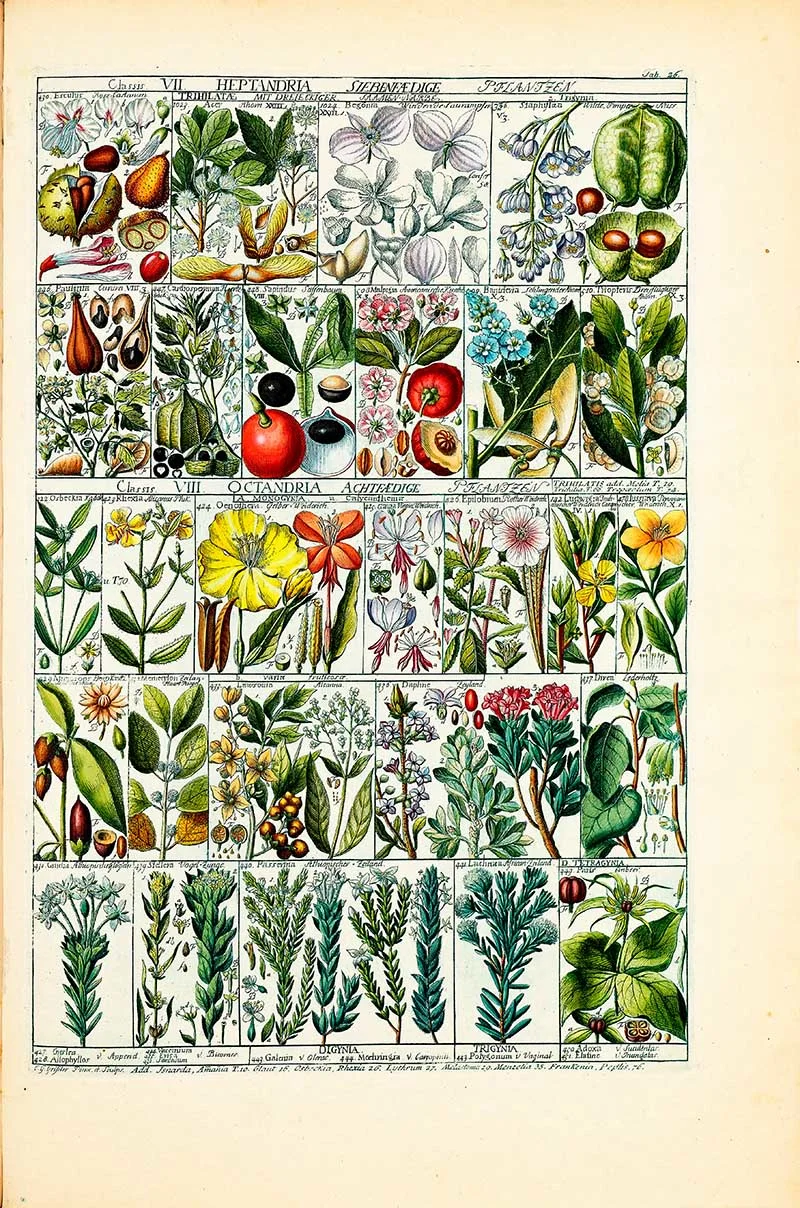
Vintage Botany Plant Table 27: Enneandria Plants
Enneandria is a class of plants in which the flowers have nine stamens. Some examples of Enneandria plants painted by Gessner include:
- Amaryllis belladonna – Belladonna lily
- Nymphaea alba – White water lily
- Passiflora incarnata – Purple passionflower
- Ruta graveolens – Common rue
- Vinca minor – Lesser periwinkle
- Lilium martagon – Turk’s cap lily
- Fritillaria meleagris – Snake’s head fritillary
- Trillium erectum – Red trillium
- Sanguinaria canadensis – Bloodroot
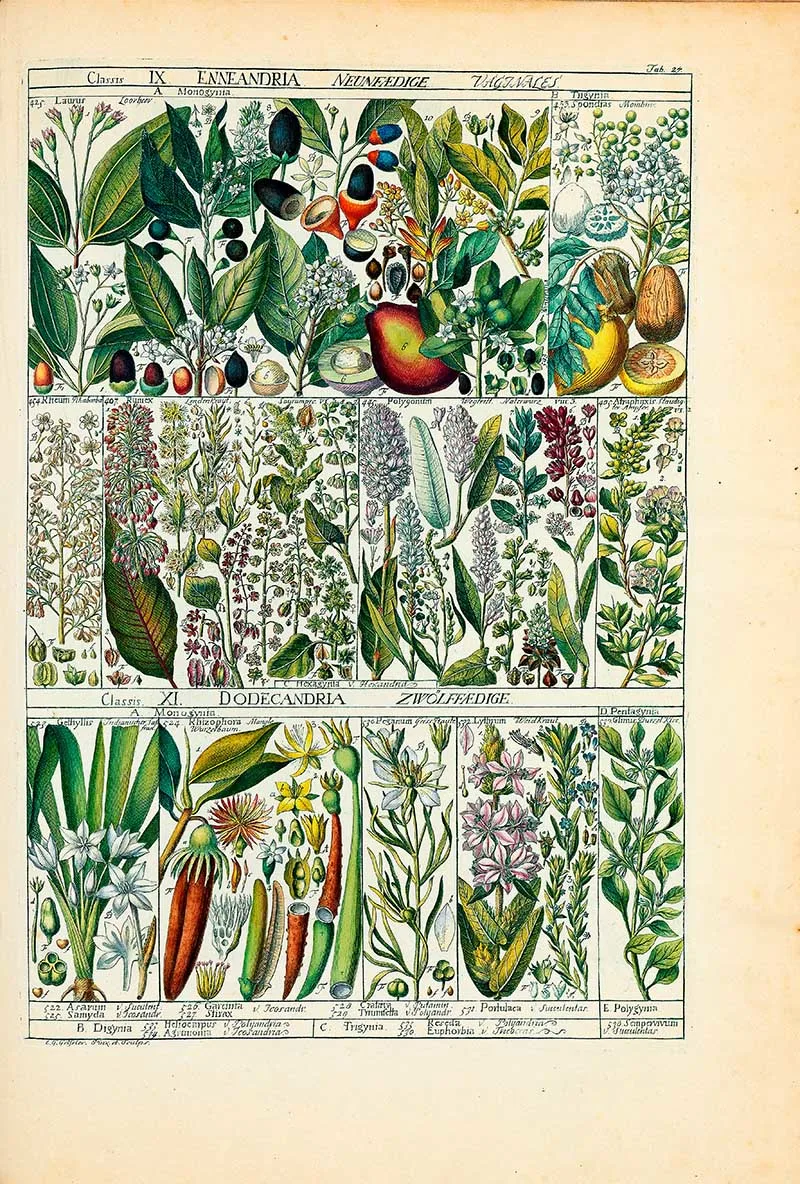
Vintage Botany Table 28 Decandria Plants
Decandria is a class of plants in which the flowers have ten stamens. Some examples of Decandria plants painted by Gessner include:
- Malus domestica – Apple tree
- Prunus domestica – Plum tree
- Rosa canina – Dog rose
- Annona cherimola – Cherimoya
- Datura stramonium – Jimsonweed
- Digitalis purpurea – Foxglove
- Ocimum basilicum – Sweet basil
- Arum maculatum – Cuckoo pint
- Asclepias syriaca – Common milkweed
- Calendula officinalis – Pot marigold
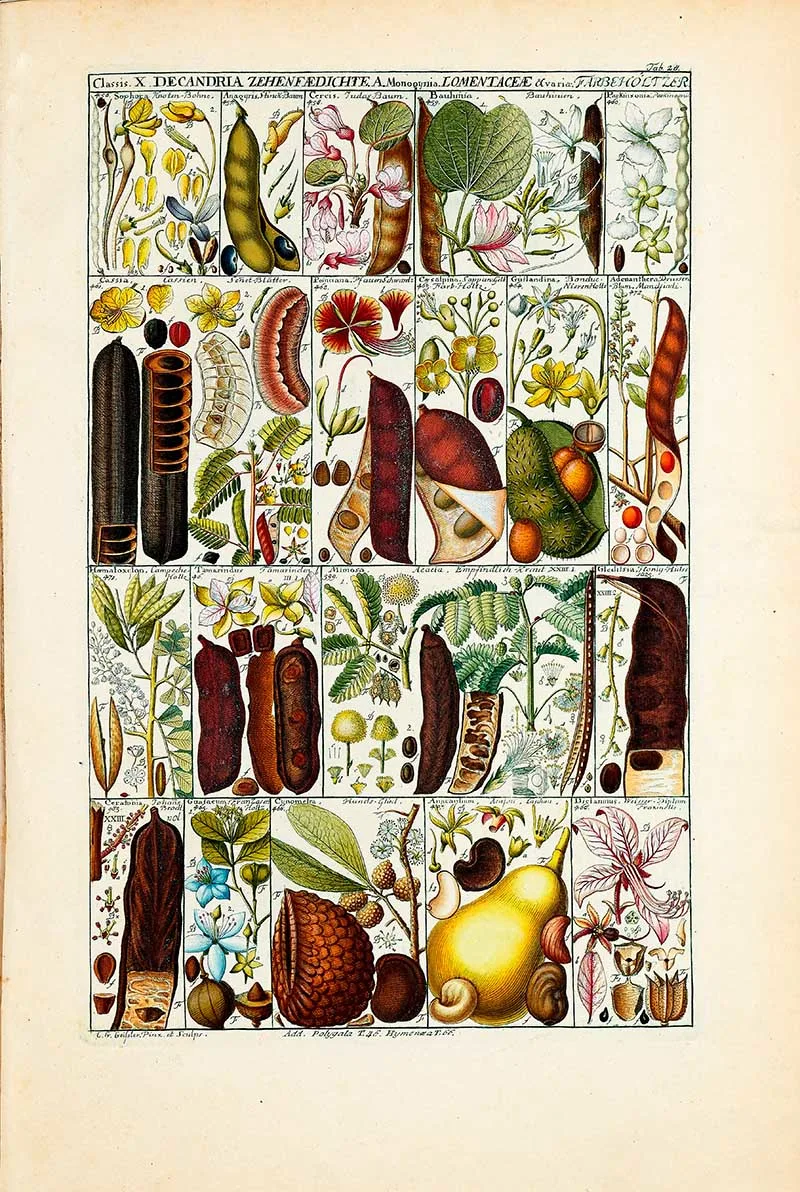
Interestingly, in this collection of plant tables painted by Johannes Gessner, there are no octandria plants (eight stamens); if you know why I’d love to hear it!
Other Vintage Botanical Prints
If you liked these of Gessner, then you will enjoy the Adolphe Millot Botanical posters.
Also take a loot at the Larouse tree posters and Harriet Isabel Adams wild flower illustrations.
If you fancy, you can Buy Me A Coffee Here.
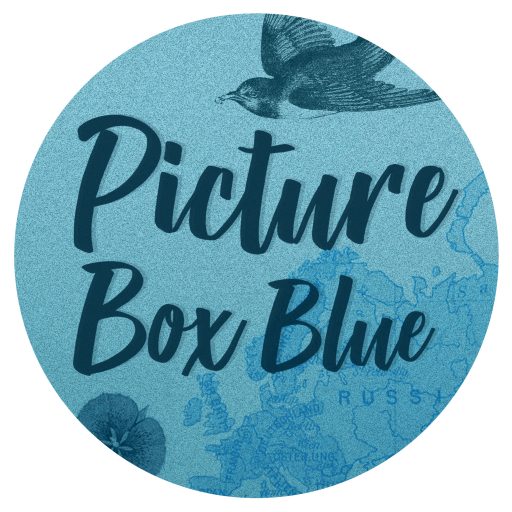
Cara ~ Vintage Style Gal
Wednesday 5th of April 2023
Beautiful! I am thinking about how I can incorporate them into my decor. Thank you for sharing with Whimsy Home Wednesday!
claire
Saturday 8th of April 2023
Thank you, Yes they are stunning.
annie.r.collages
Tuesday 4th of April 2023
ces planches botaniques sont très belles, merci beaucoup pour le partage
claire
Wednesday 5th of April 2023
Thank you, yes, they are stunning, and you're welcome.